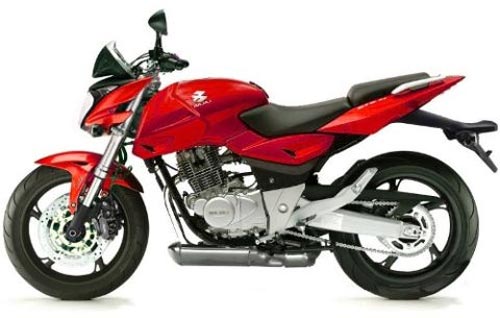 | « Back to article | Print this article |
IN PICS: 10 years of Bajaj Pulsar
It has been a decade since Bajaj launched its bestselling bike model -- Pulsar. Here's looking back at the bike that changed the way we travel.
If you go back 10 years to review the history of Indian bike market, you'd notice that various Hero Honda bikes dominated the scene.
It was difficult for any other company to launch its bike against any Hero Honda bike.
Although another domestic two-wheeler manufacturing company, Bajaj Auto had a good stake in Indian two-wheeler market and had successfully launched Kawasaki Bajaj and Bajaj Boxer in the 100 cc segment, those efforts were not satisfactory to compete with the dominating leader Hero Honda.
Kawasaki had almost lost its stake in market and the charisma of Bajaj Boxer was also on decline.
It was then that Bajaj Auto in joint efforts with Japanese bike-designing firm R&D anticipated the idea of launching its new bike, which in following years created the history of success and totally changed the scenario of Indian bike market.
In 2001 Bajaj's hard endeavours got a perfect shape when it launched its Bajaj Pulsar that within a short span of time became the first choice of every Indian bike rider.
The story of success that Bajaj Pulsar and its successors created was never imagined. Not even the designers had ever thought that they were creating an illustration to be followed by the coming generations.
At present, four variants of Bajaj Pulsar with varied engine efficiency are available in Indian bike market, energised with different engine capacities -- 135cc, 150cc, 180cc, and 220cc.
With 43 per cent stake, Bajaj Pulsar 150cc engine bike is a highly acclaimed bike in Indian bike market.
Before the emergence of Pulsar, Indian bikes were mainly engineered with engine capacity varying between 80 and 125 cc. Riding this powerful bike was like a dream for bike riders.
It was the launch of Hero Honda CBZ in 1999 that paved a way for other manufacturers to focus on manufacturing bikes beyond 100 cc; and then the outcome was what we see in the form of Bajaj Pulsar.
Courtesy:
Bajaj Pulsar 150 cc
The first generation of Bajaj Pulsar adorned 150 cc air-cooled single cylinders with four-stroke engine generating a maximum power of 13 HP.
For the first time, disc brakes were integrated in bikes in the history of Indian bikes.
Bajaj Pulsar with its launch received an overwhelming response from the customers as they accepted the bike with open arms. Hence, in a short span of time, Bajaj Pulsar ruled the hearts of Indian bike riders.
Bajaj Pulsar 135 DTS-i
Encouraged by the huge success of first generation Bajaj Pulsar, Bajaj in December 2009 launched another sibling of Bajaj Pulsar with 135 cc engine displacement.
It was in this variant that Bajaj introduced the DTS-i technology that boosted up the engine capacity and fuel efficiency of the bike.
This variant generated a power of 8.35 BHP and a torque of 11.4 Nm.
Bajaj Pulsar 150 DTS-i
Designed on the same platform as introduced in the second-generation bike, Bajaj Pulsar 150 DTS-i, rear shock absorbers were replaced by gas-filled nitrox absorbers.
Powered with 150 cc engine this bike generated a power of 15.06 BHP and a torque of 12.5 Nm.
Bajaj Pulsar 180 DTS-i
After the introduction of DTS-i technology, Bajaj made the custom of introducing this technology in every variant of its Bajaj Pulsar brand of bike with upgraded features.
This bike is capable of generating a power of 17.02 BHP and a torque of 14.22 Nm.
Bajaj Pulsar 200 DTS-i
Generating a power of 18.01 BHP and a torque of 17.68 Nm, this enhanced version of Bajaj Pulsar as 220 DTS-i was enriched with pilot lamps, turn indicators supported by clear lenses, amber bulb that reduced vibration and improved gears.
Bajaj Pulsar 220 DTS-Fi
With enhanced fuel injection, oil-cooled engines, digital dash, and stylish looks Pulsar 220 DTS-Fi made its debut in Indian bike market in 2007.
It was capable of chalking out a power of 19.79 BHP and a torque of 19.12 Nm.
With a maximum power of 21.04 BHP and a torque of 19.12 Nm, this variant upholds wide array of various new modifications and cosmetic surgery including oil cooler to control oil temperature during high speed rides, front and rear tubeless tyres, and newly introduced digital console.
Bajaj Pulsar 220 DTS-i
Continuing with the features of Pulsar 220, except the front facing that is quite similar to that as was introduced in its erstwhile sibling, Bajaj Pulsar 150 and Bajaj Pulsar 180, this variants chalks out a power of 21.04 BHP and a torque of 191.2 Nm and is one of the most preferred bike in its segment in Indian bike market.
Bajaj Pulsar 250 CC
Rumour has it that Bajaj is all set to take another step. The bike giant is supposedly planning to launch the Bajaj Pulsar 250 cc bike.
Although all this is still an anticipation, but if these rumours are true then it is quite sure that enriched and lavished by previous experiences, this variant will also take the name of Bajaj Auto to new heights, may be even to the top as against its second position in Indian bike market as of now.








